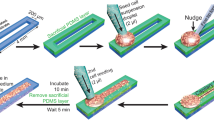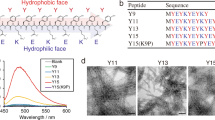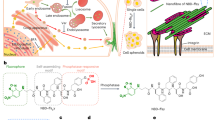Abstract
We have developed a method for promoting cell aggregation with bifunctional macromolecules synthesized by coupling cell-binding peptides to an inert, water-soluble polymer. The peptides Arg-Gly-Asp (RGD) and Tyr-Ile-Gly-Ser-Arg (YIGSR) were conjugated through their amino termini to both ends of linear poly(ethylene glycol) (PEG), producing bifunctional hybrid polymers: RGD-PEG-RGD and YIGSR-PEG-YIGSR. RGD-PEG-RGD promoted aggregation of mechanically-dissociated fetal brain cells, pheochromocytoma cells (PC12), and neuroblastoma cells maintained in rotation culture at 37°C. Enhanced aggregation was noticeable within 10 minutes and became more pronounced over the next several hours: after 7–9 hours, the mean aggregate volume was up to 10 times larger than the mean volume produced in suspensions containing unmodified PEG. Similar results were obtained with YIGSR-PEG-YIGSR and PC12 cells. Enhancement in aggregation correlated with the ability of soluble RGD or YIGSR to inhibit cell adhesion to surfaces coated with laminin or fibronectin. This method for promoting aggregation may be useful for large scale culture of anchorage dependent cells, eliminating the need for microcarriers. In addition, aggregates formed by this method may be suitable for use in artificial organs or as cell transplants for tissue regeneration.
This is a preview of subscription content, access via your institution
Access options
Subscribe to this journal
Receive 12 print issues and online access
$209.00 per year
only $17.42 per issue
Buy this article
- Purchase on Springer Link
- Instant access to full article PDF
Prices may be subject to local taxes which are calculated during checkout
Similar content being viewed by others
References
Koide, N., Shinji, T., Tanabe, T., Asano, K., Kawaguchi, M., Kaguchi, K., Koide, Y., Mori, M. and Tsuji, T. 1989. Continued high albumin production by multicellular spheroids of adult rat hepatocytes formed in the presence of liver-derived proteoglycans. Biochemical and Biophysical Research Communications 161: 385–391.
Landry, J., Bernier, D., Ouellet, C., Goyette, R. and Marceau, N. 1985. Spheroidal aggregate culture of rat liver cells: histotypic reorganization, biomatrix deposition and maintenance of functional activities. The Journal of Cell Biology 101: 914–923.
Parsons-Wingerter, P. and Saltzman, W.M. 1993. Growth versus function in three-dimensional culture of single and aggregated hepatocytes within collagen gels. Biotechnology Progress 9: 600–607.
Cirulli, V., Halban, P.A. and Rouiller, D.G. 1993. Tumor necrosis factor-α modifies adhesion properties of rat islet B cells. Journal of Clinical Investigation 91: 1868–1876.
Matthieu, J., Honegger, P., Favrod, P., Poduslo, J. and Krstic, R. 1981. Aggregating brain cell cultures: A model to study brain development, p. 359–366. In: Physiological and Biocehmical Basis for Perinatal Medicine, M. Monset-Couchard and A. Minkowski (Eds.). Karger, Basel.
Peshwa, M.V., Kyung, S.-Y., McClure, D.B. and Hu, W.-S. 1993. Cultivation of mammalian cell aggregates in bioreactors—effect of calcium concentration on spatial distribution of viability. Biotechnol. Bioeng. 41: 179–187.
Nyberg, S.L., Shatford, R.A., Peshwa, M.V., White, J.G. and Hu, W.-S. 1993. Evaluation of a Hepatocyte-Entrapment Hollow Fiber Bioreactor: A Potential Bioartificial Liver. Biotechnol. and Bioengin. 41: 194–203.
Langer, R. and Vacanti, J.P. 1993. Tissue engineering. Science 260: 920–932.
Moscona, A.A. 1961. Rotation-mediated histogenic aggregation of dissociated cells. Experimental Cell Research 22: 455–475.
Matsuda, M. 1988. Serum proteins enhance aggregate formation of dissociated fetal rat brain cells in an aggregating culture. In Vitro Cellular and Developmental Biology 24: 1031–1036.
Takezawa, T., Mori, Y., Yonaha, T. and Yoshizato, K. 1993. Characterization of morphology and cellular metabolism during the spheroid formation by fibro-blasts. Experimental Cell Research 208: 430–441.
Ruoslahti, E. and Pierschbacher, M. 1987. New Perspectives in Cell Adhesion: ROD and Integrins. Science 238: 491–497.
Springer, T. 1990. Adhesion receptors of the immune system. Nature 346: 425–434.
Graf, J., Ogle, R.C., Robey, F.A., Sasaki, M., Martin, G.R., Yamada, Y. and Kleinman, H.K. 1987. A pentapeptide from the laminin B1 chain mediates cell adhesion and binds the 67,000 laminin receptor. Biochemistry 26: 6896–6900.
Pierschbacher, M.D. and Ruoslahti, E. 1984. Cell attachment activity of fibronectin can be duplicated by small synthetic fragments of the molecule. Nature 309: 30–33.
Massia, S.P., Rao, S.S. and Hubbell, J.A. 1993. Covalently immobilized laminin peptide tyr-ile-gly-ser-arg (YIGSR) supports cell spreading and colocalization of the 67-kilodalton laminin receptor with alpha-actinin and vinculin. J. Biol. Chem. 268: 8053–8059.
Massia, S.P. and Hubbell, J.A. 1991. An RGD spacing of 440 nm is sufficient for Integrin αV/β3-mediated fibroblast spreading and 140 nm for focal contact and stress fiber formation. The Journal of Cell Biology 114: 1089–1100.
Dodd, J. and Jessel, T.M. 1988. Axon guidance and the patterning of neuronal projections in vertebrates. Science 242: 692–699.
Letourneau, P.C., Condic, M.L. and Snow, D.M. 1994. Interactions of developing neurons with the extracellular matrix. The J. of Neuroscience 14: 915–928.
Widner, H., Tetrud, J., Rehncrona, S., Snow, B., Brundin, P., Gustavii, B., Bjorklund, A., Lindvall, O. and Langston, J.W. 1992. Bilateral fetal mesencephalic grafting in two patients with parkinsonism induced by 1-methyl-4-phenyl-1,2,3,6-tetrahydropyridine (MPTP). New Eng. J. of Med. 327: 1556–1563.
Freed, C.R., Breeze, R.E., Rosenberg, N.L., Schneck, S.A., Kriek, E., Qi, J.-X., Lone, T., Zhang Y., Snyder, J.A., Wells, T.H., Ramig, L.O., Thompson, L., Mazziotta, J.C., Huang, S.C., Grafton, S.T., Brooks, D., Sawle, G., Schroter, G. and Ansari, A.A. 1992. Survival of implanted fetal dopamine cells and neurological improvement 12 to 46 months after transplantation. New Eng. J. of Med. 327: 1549–1555.
Spencer, D.D., Robbins, R.J., Naftolin,F., Marek, K.L., Vollmer, T., Leranth, C., Roth, R.H., Price, L.H., Gjedde, A., Bunney, B.S., Sass, K.J., Elsworth, J.D., Kier, E.L., Makuch, R., Hoffer, P.B. and Redmond, D.E. 1992. Unilateral transplantation of human fetal mesencephalic tissue into the caudate nucleus of patients with Parkinson's disease. New Eng. J. of Med. 327: 1541–1548.
Sephel, G.C., Tashiro, K.-I., Sasaki, M., Greatorex, D., Martin, G.R., Yamada, Y. and Kleinman, H.K. 1989. Laminin A chain synthetic peptide which supports neurite outgrowth. Biochem. and Biophys. Res. Comm. 162: 821–829.
Tashiro, K., Sephel, G.C., Weeks, B., Sasaki, M., Martin, G.R., Kleinman, H.K. and Yamada, Y. 1989. A synthetic peptide containing the IKVAV sequence from the A chain of laminin mediates cell attachment, migration, and neurite outgrowth. J. of Biol. Chem. 264: 16174–16182.
Tomaselli, K.J., Hall, D.E., Flier, L.A., Gehlsen, K.R., Turner, D.C., Carbonetto, S. and Reichardt, L.F. 1990. A neuronal cell line (PC12) expresses two b1-class integrins—α1β1 and α3β1—that recognize different neurite outgrowth promoting domains in laminin. Neuron 5: 651–662.
Tiller, C.L. and O'Melia, C.R. 1993. Natural organic matter and colloidal stability: models and measurements. Colloids and Surfaces A: Physicochemical and engineering aspects 73: 89–102.
Lauffenburger, D.A. and Linderman, J.J. 1993. Receptors: Models for Binding, Trafficking, and Signaling. Oxford University Press, New York.
Abuchowski, A., McCoy, J.R., Palczuk, N.C., van Es, T. and Davis, F.F. 1977. Effect of covalent attachment of polyethylene glycol on immunogenicity and circulating life of bovine liver catalase. J. of Biol. Chem. 252: 3582–3586.
Hershfield, M.S., Buckley, R.H., Greenberg, M.L., Melton, A.L., Schiff, R., Hatem, C., Kurtzberg, J., Markert, M.L., Kobayashi, R.H., Kobayashi, A.L. and Abuchowski, A. 1987. Treatment of adenosine deaminase deficiency with polyethylene glycol-modified adenosine deaminase. The New Eng. J. of Med. 316: 589–596.
Nagaoka, S., Mori,Y., Takiuchi, H., Yokata, K., Tanzawa, H. and Nishiumi, S. 1984. Interaction between blood components and hydrogels with poly (oxy-ethylene) chains, p. 361–375. In: Polymers as Biomaterials, Shalaby, S. W., Hoffman, A. S., Ratner, B. D. and Horbett, T. A. (Eds. ). Plenum Press, New York.
Sawhnay, A.S., Pathak, C.P. and Hubbell, J.A. 1993. Interfacial photopolymerization of poly(ethylene glycol)-based hydrogels upon alginate-poly (L-lysine) microcapsules for enhanced biocompatibility. Biomaterials 14: 1008–1016.
Humphries, M.J., Olden, K. and Yamada, K.M. 1986. A synthetic peptide from fibronectin inhibits experimental metastasis of murine melanoma cells. Science 233: 467–470.
Iwamato, Y., Robey, F.A., Graf, J., Sasaki, M., Kleinman, H.K., Yamada, Y. and Martin, G.R. 1987. YIGSR, a synthetic laminin pentapeptide, inhibits experimental metastasis formation. Science 238: 1132–1134.
Saiki, I., Murata, J., Iida, J., Sakurai, T., Nishi, N., Matsuno, K. and Azuma, I. 1989. Antimetastatic effects of synthetic polypeptides containing repeated structures of the cell adhesive Arg-Gly-Asp (RGD) and Tyr-De-Gly-Ser-Arg (YIGSR) sequences. Brit. J. of Cancer 60: 722–728.
Saiki, I., Yoneda, J., Igarashi,Y., Aoki, M., Kusunose, N., Ono, K. and Asuma, I. 1993. Antimetastatic activity of polymeric RGDT peptdies conjugates with poly(ethylene glycol). Japan. J. of Cancer Res. 84: 558–565.
Author information
Authors and Affiliations
Corresponding author
Rights and permissions
About this article
Cite this article
Dai, W., Belt, J. & Saltzman, W. Cell-binding Peptides Conjugated to Poly(ethylene glycol) Promote Neural Cell Aggregation. Nat Biotechnol 12, 797–801 (1994). https://doi.org/10.1038/nbt0894-797
Received:
Accepted:
Issue Date:
DOI: https://doi.org/10.1038/nbt0894-797



